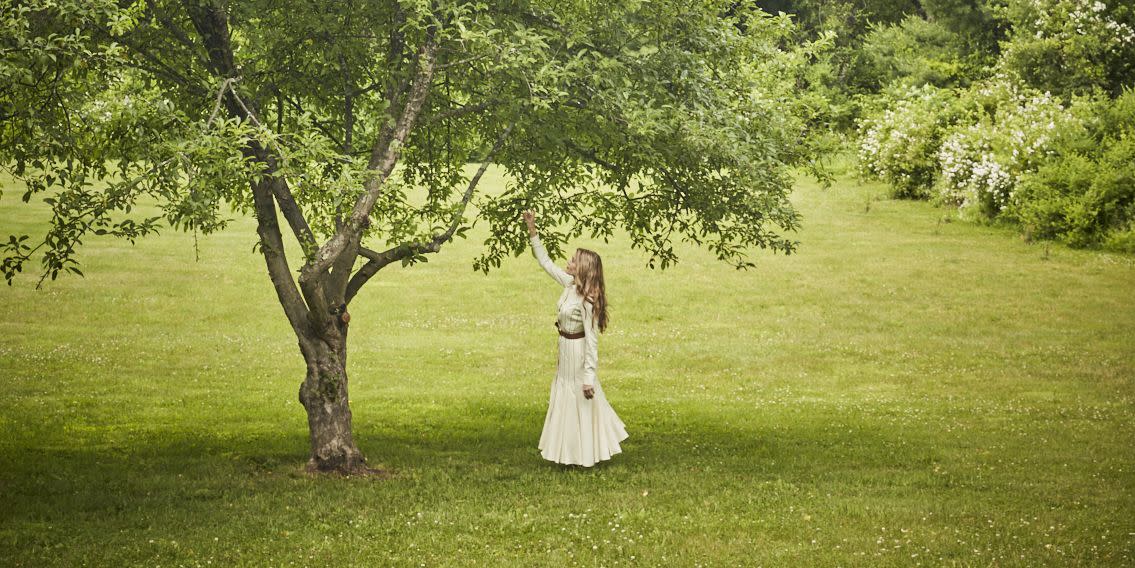Can Dr. Macrene Alexiades Replace Procedures with Plants?

Dr. Macrene Alexiades is sure. She is sure that the white flowering plant Galium aparine, which is currently encircling her lush 14-acre property in Milan, New York, will make a fantastic remedy for burns. She is sure that the plants she is growing there, in a petite medicinal garden planted next to a newly painted charcoal-gray log cabin, will change the way we age. And she is sure that, though she has built her Manhattan dermatology practice on the power of lasers and injectables to slow down the aging process, she won’t have much use for them in a few years’ time.
“I believe I’ve made procedures obsolete,” she says, speaking at a confident clip. “I believe I’ve replaced them with active ingredients. I’m proof. Look at me. This is crazy. I don’t do any injectables; I don’t do any lasers. I think this is all from active ingredients.”

Lest you think the 52-year-old has genetics to thank for her strong jaw and smooth skin, she is quick to correct you. “I’ve had my genetic analysis done,” she says. “I’m supposed to look four years older than I am, based on my telomerase activity.”
It’s uncommon to hear any doctor—let alone one who is writing a textbook called Cosmetic Dermatologic Surgery—speak so boldly about botanicals. But the Park Avenue derm was working on bugs and plants long before she started tending to the complexions of queens (and princesses and supermodels).
“I started out in research when I was 12, because I read Rachel Carson’s Silent Spring,” Alexiades says of the 1962 environmental manifesto. “I was looking for nontoxic modes of pest control.” Though she went on to become a Fulbright scholar, spending a year in Crete researching GMO alternatives, and earned a PhD in genetics from Harvard, she took up dermatology at a time when the field was starting to explode, with its newly available arsenal of get-younger-quick toys.
Now her latest project is bringing her back to her early work—and the time she spent in her grandmother Aphrodite’s half-acre garden in Jamaica Estates, Queens. There she helped plant green beans and water-melons and grapes, saving the grape leaves for dolmades. “She really taught me how you baby plants into doing what you want, giving them the same love you would an animal,” Alexiades says. “That’s loving the earth.”

She first fell in love with the Dutchess County area as a dermatology resident, and she has spent many birthdays at the Beekman Arms, in Rhinebeck. But she knew it was time to buy when she found the Milan property, which she suspected had prime soil thanks to its former life as part of the nearby Battenfeld’s Christmas Tree Farm. She also found that the town’s low-key vibe suited her and her two children, Sophia, 20, and Anthony, 17, their Swiss shepherd, Zeus, and their teacup Persian cat, Cleopatra. “With what I do for a living, it’s impossible to be off duty. People are coming up to you at parties and showing you pimples,” she says. “I need a time to be quiet and not have to work.”

Well, not work with patients. At her new home, which she has named Meraki (the Greek word for doing something with good taste and passion), she coaxes plants into growing so she can use them in Macrene Actives (formerly 37 Actives), the newly reformulated luxe and minimalist beauty line she launched a decade ago.
“The motivation for buying the farm was I didn’t trust other people with my active ingredients anymore,” she says. “I wanted to make my own.” It’s not just that the arnica, St. John’s wort, echinacea, comfrey, and milk thistle, for starters, will be grown organically and extracted in liquid nitrogen in a basement lab, she says, but that she can ensure ingredients’ activity and stability for three years by using a formula that goes well beyond the now standard paraben-, phthalate-, and -sulfate-free labels.
“Organic alone is not cutting it,” Alexiades says. “USDA Organic is helpful for food, but the problem is that when you get to skincare it encourages people to develop very simplistic products that are made of groupings of oils that are not good for the skin. They’re not achieving the goals that we’re interested in.”
Alexiades believes she has just the topical thing to actually change the way skin ages. In nearly every product in the Macrene Actives line, there are peptides for wrinkles, hyaluronic acid to promote plumpness, antioxidants for protection, algae and marine-derived ingredients for DNA repair, amino acids for brown spots, caffeine and feverfew for redness, and essential fatty acids for barrier repair. Alexiades is fond of saying there are now more than 50 actives, not 37, and that since so many of the properties of plants remain unexplored, there are actually thousands of reactions taking place. “I look at myself as the modern Estée Lauder,” she says. “I want to be the pioneer, because if we do the work of actually identifying what’s in our active ingredients, we’re going to find it’s a gold mine. That’s something that will be my legacy for future generations of people in the beauty industry.”
For now she’s hoping to inspire skincare compliance, in the same way we don’t think twice about brushing our teeth every day. “People need to have the same belief system that has been set up for dentistry,” she says. Naturally, she adds, it would have to be with her products, not just any old cream. “The answer is not to paralyze your face” with too many procedures, she says. “The answer is good skin.”
This story appears in the October 2019 issue of Town & Country. SUBSCRIBE NOW
You Might Also Like
